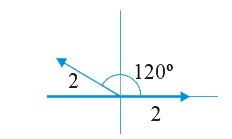Two equal vectors are inclined at 60∘ .At what direction does the resultant act with the first vector ?
To solve the problem of finding the direction of the resultant vector when two equal vectors are inclined at an angle of 60∘, we can follow these steps:
1. Understanding the Vectors:
Let the two equal vectors be represented as →A and →B, both having the same magnitude A. The angle between them is given as 60∘.
2. Using the Law of Cosines:
The magnitude of the resultant vector →R can be calculated using the formula:
R=√A2+A2+2A⋅A⋅cos(60∘)
Since cos(60∘)=12, we can substitute this value into the equation:
R=√A2+A2+2A2⋅12=√A2+A2+A2=√3A2=A√3
3. Finding the Angle of the Resultant:
To find the angle α that the resultant vector →R makes with the first vector →A, we can use the tangent formula:
tan(α)=|→B|sin(60∘)|→A|+|→B|cos(60∘)
Substituting the values:
tan(α)=A⋅√32A+A⋅12=A⋅√32A+A2=A⋅√323A2=√33
4. Calculating the Angle:
Now, we can find α:
tan(α)=1√3⟹α=30∘
5. Conclusion:
Therefore, the resultant vector makes an angle of 30∘ with the first vector →A.
Final Answer:
The resultant vector acts at an angle of 30∘ with the first vector.
Let the two equal vectors be represented as →A and →B, both having the same magnitude A. The angle between them is given as 60∘.
The magnitude of the resultant vector →R can be calculated using the formula:
R=√A2+A2+2A⋅A⋅cos(60∘)
Since cos(60∘)=12, we can substitute this value into the equation:
R=√A2+A2+2A2⋅12=√A2+A2+A2=√3A2=A√3
To find the angle α that the resultant vector →R makes with the first vector →A, we can use the tangent formula:
tan(α)=|→B|sin(60∘)|→A|+|→B|cos(60∘)
Substituting the values:
tan(α)=A⋅√32A+A⋅12=A⋅√32A+A2=A⋅√323A2=√33
Now, we can find α:
tan(α)=1√3⟹α=30∘
Therefore, the resultant vector makes an angle of 30∘ with the first vector →A.
The resultant vector acts at an angle of 30∘ with the first vector.
Topper's Solved these Questions
- VECTORS SCALARS ELEMENTARY CALCULUS BOOK - ICSECHAPTER - VECTORS SCALARS ELEMENTARY CALCULUS EXERCISE - EXAMPLES
26 Videos
- VECTORS SCALARS ELEMENTARY CALCULUS BOOK - ICSECHAPTER - VECTORS SCALARS ELEMENTARY CALCULUS EXERCISE - Applications of integration in Physics
6 Videos
- VECTORS SCALARS ELEMENTARY CALCULUS BOOK - ICSECHAPTER - VECTORS SCALARS ELEMENTARY CALCULUS EXERCISE - UNSOLVED PROBLEMS
79 Videos
- UNITSBOOK - ICSECHAPTER - UNITSEXERCISE - MODULE 3 (SELECTED PROBLEMS)
38 Videos
- WAVESBOOK - ICSECHAPTER - WAVESEXERCISE - From Musical Sound
10 Videos
Similar Questions
Two unequal vectors are inclined at an angle 30∘. When they are added, the resultant can be :
View SolutionFind the magnitude and direction of the resultant of given vectors

View SolutionWhat is a resultant vector ?
View SolutionIf three unit vectors are inclined at an angle of 60∘ with each other, then the magnitude of their resultant vector will be
View SolutionCan the resultant of two vector be zero
View SolutionTwo vectors 3 units and 5 units are acting at 60∘ to each other .What is the magnitude and direction of the resultant ?
View SolutionTwo force each numerically equal to 10 dynes are acting as shown in the figure, then find resultant of these two vectors.
View SolutionHow will you find the direction of the vector product of two vectors ?
View SolutionThe resultant of two vectors makes an angle of 60∘ with one vector and 30∘ with one other. If the magnitude of resultant is 25, the two vectors are of magnitude
View SolutionState parallelogram law of vector addition. Find analytically the magnitude and direction of resultant vector. Apply it to find the resultant when,
(i) Two vectors are parallel to each other
(ii) Two vectors are perpendicular to each other
View Solution
